The pick of cards to illustrate members varied interests ....
This section highlights popular collecting themes from members, with cards selected for mainly historic or artistic importance starting with ,,, PIONEERS
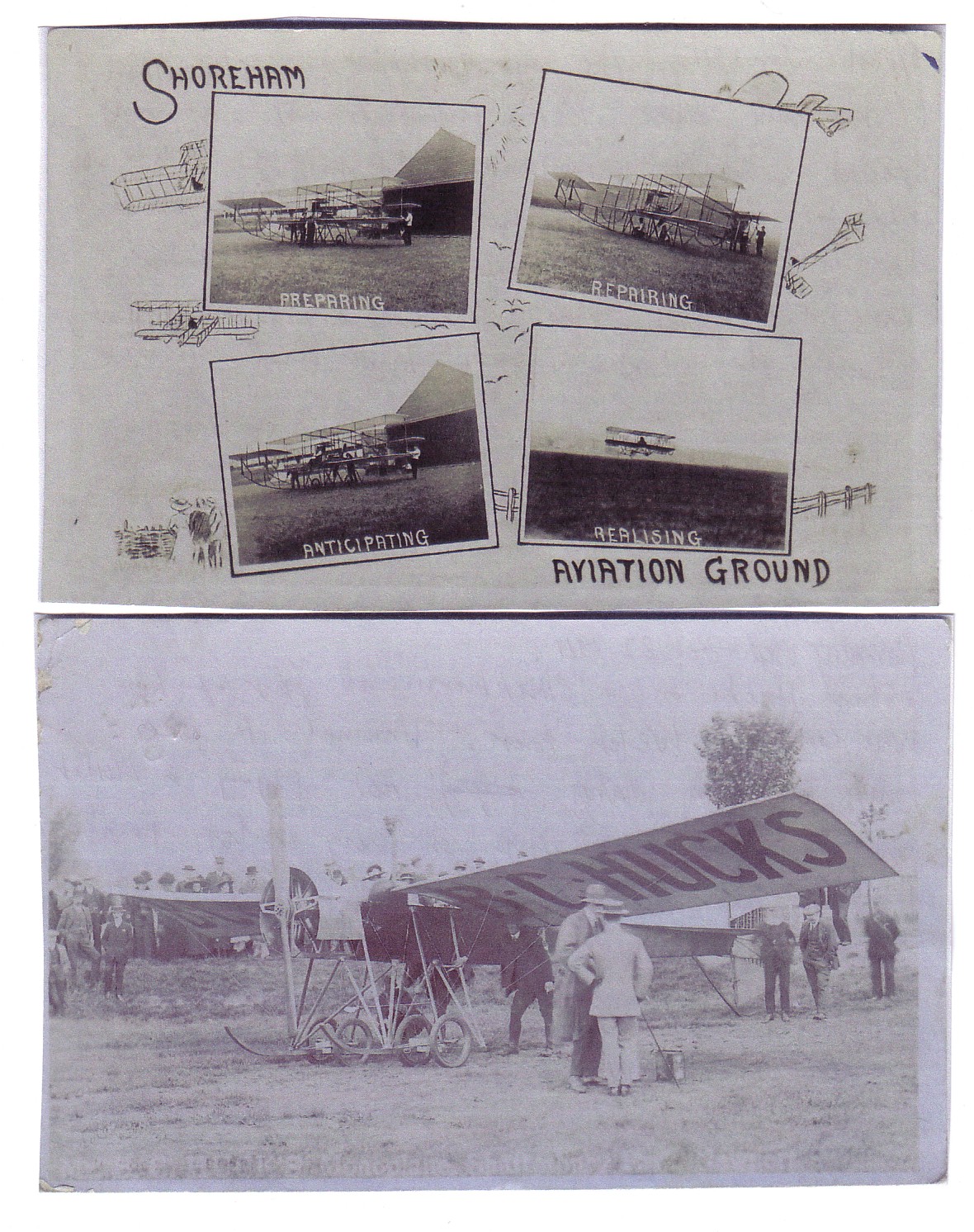 Too far back to feature in “memories” the pioneer age overlaps with the “golden age” of the picture postcard. John Worsley, Sheffield UK “ As my birthplace is Shoreham I naturally chose the “flying ground” as my special interest aerodrome. It is one of oldest commercial airfields in the UK, has a fascinating history, and is still going strong. The writer, in Jan 1911, says “I think these machines are so funny, don’t you”. They are Wrights licence built by Shorts. My second card, posted Oct 1911 shows B.C Hucks Blackburn (not his usual Bleriot) at Shaftesbury Park, Newport on his West Country/Welsh tour. The card was mailed to California with the message including “ Have you any of these flying machine in California ?”
Too far back to feature in “memories” the pioneer age overlaps with the “golden age” of the picture postcard. John Worsley, Sheffield UK “ As my birthplace is Shoreham I naturally chose the “flying ground” as my special interest aerodrome. It is one of oldest commercial airfields in the UK, has a fascinating history, and is still going strong. The writer, in Jan 1911, says “I think these machines are so funny, don’t you”. They are Wrights licence built by Shorts. My second card, posted Oct 1911 shows B.C Hucks Blackburn (not his usual Bleriot) at Shaftesbury Park, Newport on his West Country/Welsh tour. The card was mailed to California with the message including “ Have you any of these flying machine in California ?”
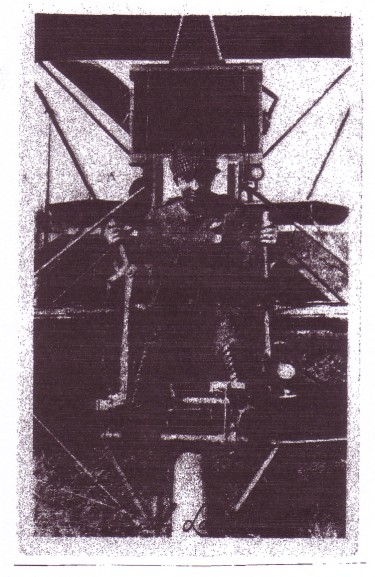 The USA surely did. One was aviatrix Ruth Law on this card from Charles Sterba, USA. Signed in ink, it was probably a souvenir card from the many aviation events she appeared at nationwide. Charles has another card featuring her at such an event in Iowa.
The USA surely did. One was aviatrix Ruth Law on this card from Charles Sterba, USA. Signed in ink, it was probably a souvenir card from the many aviation events she appeared at nationwide. Charles has another card featuring her at such an event in Iowa.
 Colin White, Kent UK provided an example of the real photo cards of Mays of Aldershot – a fine portrait of Texas born Samuel Franklin Cody – first to build and fly an aeroplane in the UK.
Colin White, Kent UK provided an example of the real photo cards of Mays of Aldershot – a fine portrait of Texas born Samuel Franklin Cody – first to build and fly an aeroplane in the UK.
 A link with Shoreham is that it was where O P Jones, later chief pilot of Imperial Airways and BOAC, learnt to fly. This shows him in his barnstorming days with an Avro 504 of Berkshire Aviation and is ink-autographed. This card will have to serve for the Imperial Airways interest, which, although strong, was not the subject of any submissions (card from Doug Bastin)
A link with Shoreham is that it was where O P Jones, later chief pilot of Imperial Airways and BOAC, learnt to fly. This shows him in his barnstorming days with an Avro 504 of Berkshire Aviation and is ink-autographed. This card will have to serve for the Imperial Airways interest, which, although strong, was not the subject of any submissions (card from Doug Bastin)
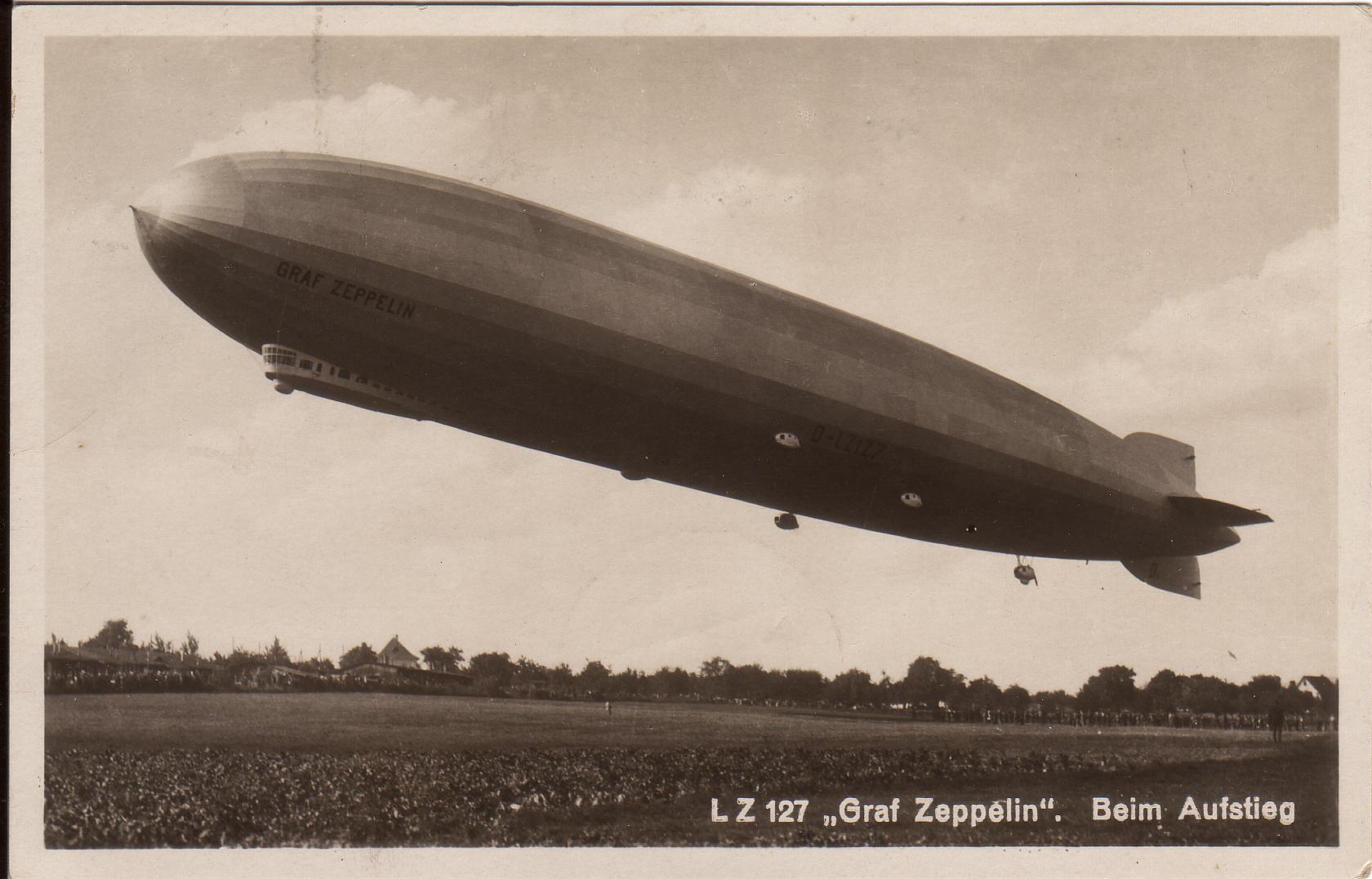 ZEPPELINS feature on 2 cards. First from Bill Trower, Essex, UK shows the “Graf Zeppelin” LZ127 and is a card written and postmarked on board on 17 Sep 1930, at Friedrichshafen . Both Zeppelin cards represent the link with the postal history interest.
ZEPPELINS feature on 2 cards. First from Bill Trower, Essex, UK shows the “Graf Zeppelin” LZ127 and is a card written and postmarked on board on 17 Sep 1930, at Friedrichshafen . Both Zeppelin cards represent the link with the postal history interest.

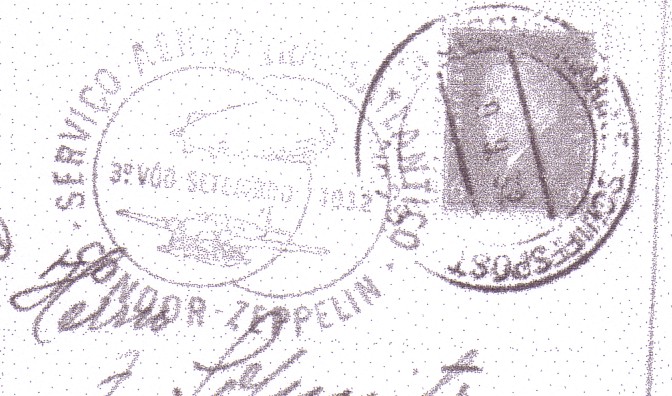 Brian Hyner, Birmingham, UK epitomises this. The card is actually of a warship, the German Cruiser Karlsruhe. The postal history/aviation link is on the back postmark. Background is that the Graf Zeppelin, on a scheduled service on 29 Sept 1932 was unable to land at Pernambuco Brazil due to the available ground crew being too few to cope with storm conditions. Assistance was sought from the crew of “Karlsruhe” which was anchored in the harbour. For services rendered, the crews’ mail was put aboard the Zeppelin, which reduced its transit time by approx one week. Naval mail used German stamps at inland rates and the cards carried both “Karlsruhe” ship mail and Zeppelin mail postmarks.
Brian Hyner, Birmingham, UK epitomises this. The card is actually of a warship, the German Cruiser Karlsruhe. The postal history/aviation link is on the back postmark. Background is that the Graf Zeppelin, on a scheduled service on 29 Sept 1932 was unable to land at Pernambuco Brazil due to the available ground crew being too few to cope with storm conditions. Assistance was sought from the crew of “Karlsruhe” which was anchored in the harbour. For services rendered, the crews’ mail was put aboard the Zeppelin, which reduced its transit time by approx one week. Naval mail used German stamps at inland rates and the cards carried both “Karlsruhe” ship mail and Zeppelin mail postmarks.
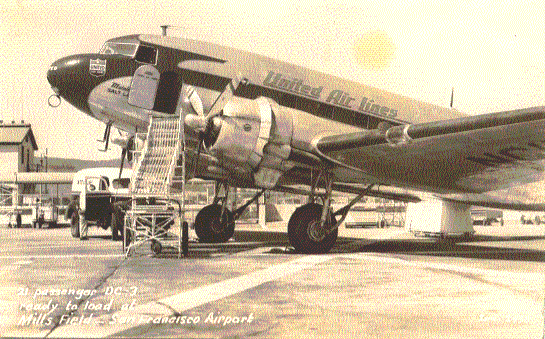 COMMERCIAL AVIATION of all periods dominates the rest of the entries but within that there are many sub-themes. AIRPORTS often yield rare types and airlines and show aircraft “as is” surrounded by people, vehicles and other apron clutter which are anathema to the “perfect aircraft shot” faction. An example of a “classic” U.S prop-era real photographic airport card is this one from Jack Greenbaum, USA, of Mills Field, San Francisco, 1940s with a United DC-3 “Mainliner”
COMMERCIAL AVIATION of all periods dominates the rest of the entries but within that there are many sub-themes. AIRPORTS often yield rare types and airlines and show aircraft “as is” surrounded by people, vehicles and other apron clutter which are anathema to the “perfect aircraft shot” faction. An example of a “classic” U.S prop-era real photographic airport card is this one from Jack Greenbaum, USA, of Mills Field, San Francisco, 1940s with a United DC-3 “Mainliner”
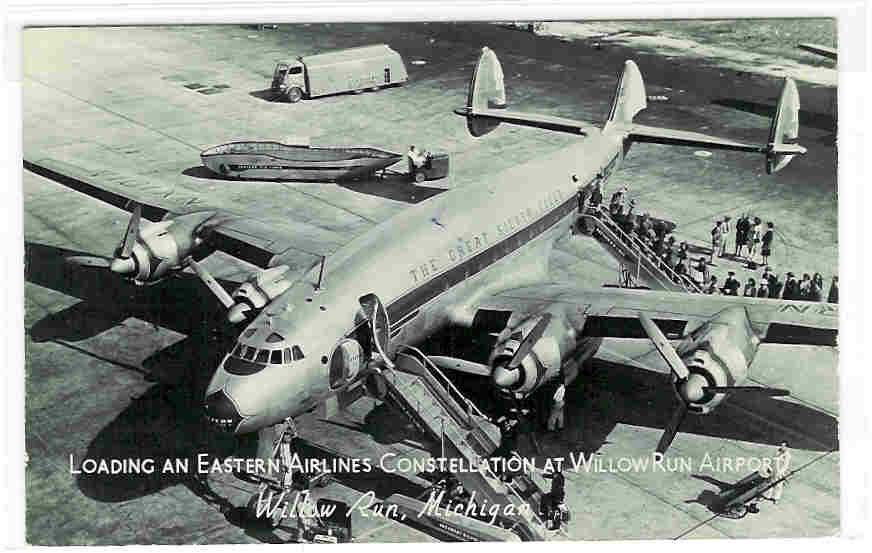 The once ubiquitous DC-3 is itself the object of many collections as also is the Lockheed Constellation as on this Eastern Airlines example at Detroit – Willow Run airport from Chris Slimmer, USA.
The once ubiquitous DC-3 is itself the object of many collections as also is the Lockheed Constellation as on this Eastern Airlines example at Detroit – Willow Run airport from Chris Slimmer, USA.
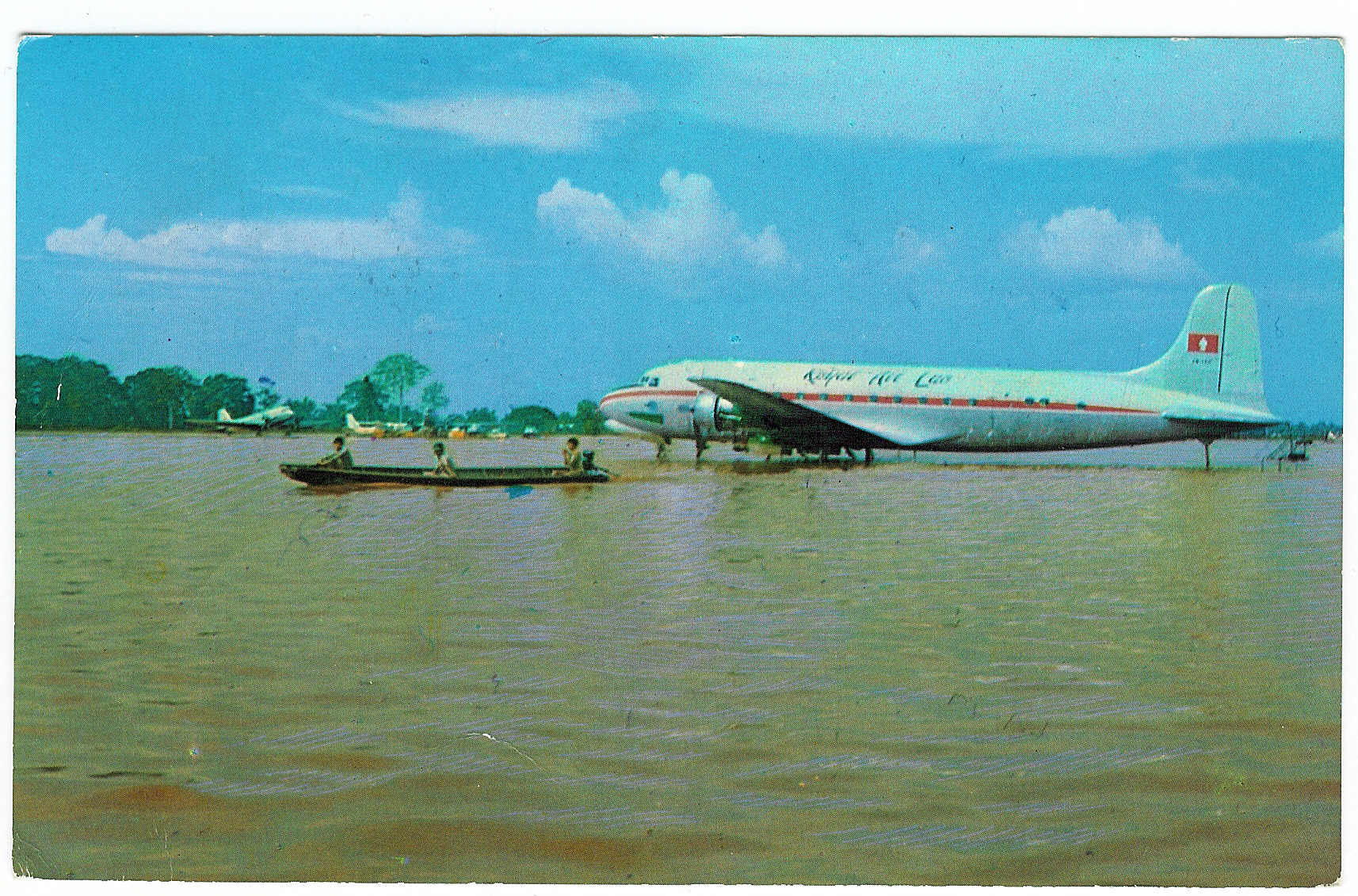 You can’t get much more obscure in Airport cards than this second card from Chris Slimmer USA. DC-4 of Royal Air Lao, at Vientiane airport, Laos, and showing the airport under floodwaters. The back text in French dates the flood to 1 Sept 1966. This also appeals to the hunter/gatherer instinct by turning up for a 25 cents at a flea market.
You can’t get much more obscure in Airport cards than this second card from Chris Slimmer USA. DC-4 of Royal Air Lao, at Vientiane airport, Laos, and showing the airport under floodwaters. The back text in French dates the flood to 1 Sept 1966. This also appeals to the hunter/gatherer instinct by turning up for a 25 cents at a flea market.
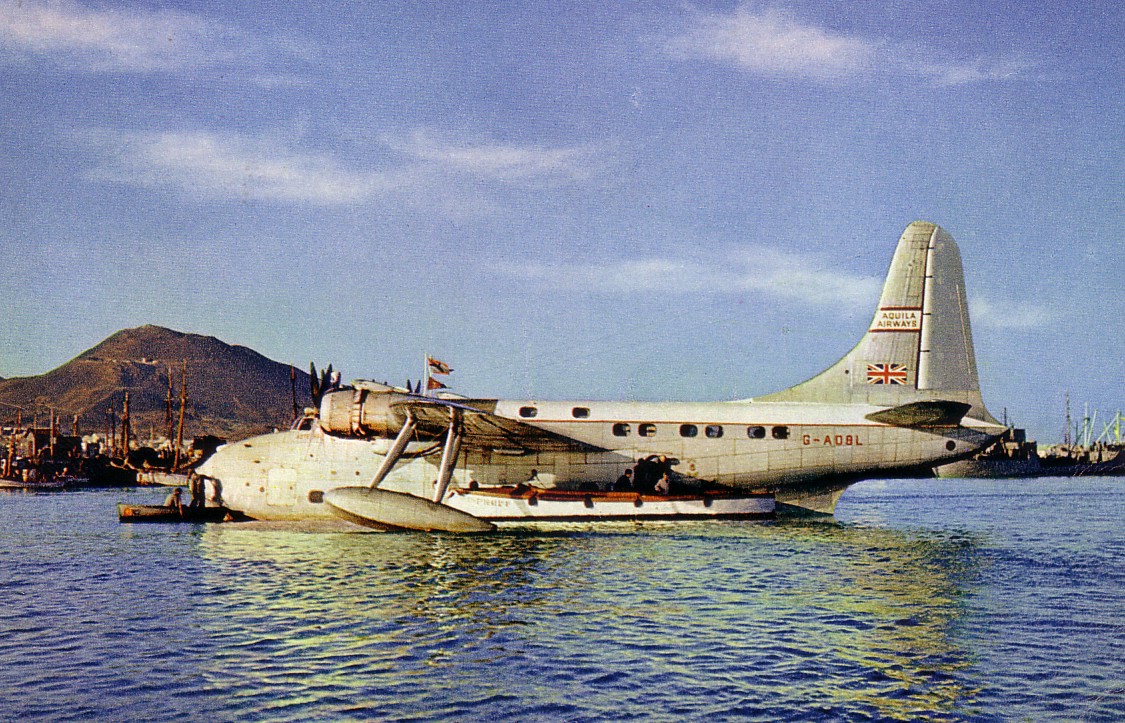 More water but this time in its right place and supporting a Short Solent of Aquila airways at Las Palmas, Canary Isles on a Dixon card. Submitted by Peter Marson, Surrey, UK but originally from Southampton, home of British flying boat operations. Flying Boats are another strong collecting theme.
More water but this time in its right place and supporting a Short Solent of Aquila airways at Las Palmas, Canary Isles on a Dixon card. Submitted by Peter Marson, Surrey, UK but originally from Southampton, home of British flying boat operations. Flying Boats are another strong collecting theme.
 More John Hinde follows (and more Nigeria), this time from Carl McQuaide Tamworth, UK combining the airport theme with other favourites VC-10 and BOAC although this one at Lagos is leased to Nigeria Airways. Like for an old Edwardian photo postcard everybody has stopped to look at the camera.
More John Hinde follows (and more Nigeria), this time from Carl McQuaide Tamworth, UK combining the airport theme with other favourites VC-10 and BOAC although this one at Lagos is leased to Nigeria Airways. Like for an old Edwardian photo postcard everybody has stopped to look at the camera.
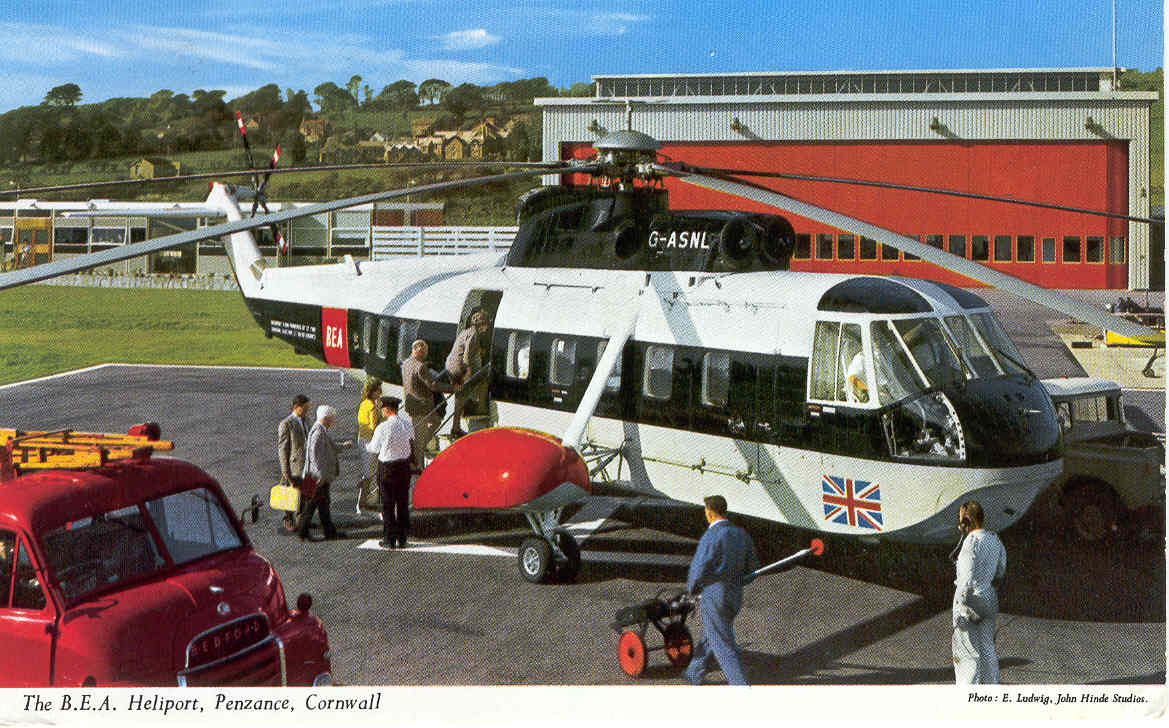 …and still they come from Irish publisher, John Hinde. A sub species of Airport, the heliport with BEA Helicopter at Penzance on the Scilly Isles service. Submitted by Brent Wallace, Canada who writes“. I selected this commonly available card for many reasons. It illustrates the first Sikorsky S-61 operated by BEA on its successful and long-lived scheduled service. The aircraft is in its original livery and the airline name and aircraft registration are visible. The image is colourful, documents the local countryside and shows the aircraft in service with all the usual activity (loading passengers, gate agent, flight crew, ground crew, vintage fire vehicle) rather than a sterile image of a lonely aircraft. I also like the fact that the card has been used. This adds context, tells a story and makes the card seem more historically significant in a folksy kind of way”
…and still they come from Irish publisher, John Hinde. A sub species of Airport, the heliport with BEA Helicopter at Penzance on the Scilly Isles service. Submitted by Brent Wallace, Canada who writes“. I selected this commonly available card for many reasons. It illustrates the first Sikorsky S-61 operated by BEA on its successful and long-lived scheduled service. The aircraft is in its original livery and the airline name and aircraft registration are visible. The image is colourful, documents the local countryside and shows the aircraft in service with all the usual activity (loading passengers, gate agent, flight crew, ground crew, vintage fire vehicle) rather than a sterile image of a lonely aircraft. I also like the fact that the card has been used. This adds context, tells a story and makes the card seem more historically significant in a folksy kind of way”
 AIRLINE ISSUE cards are probably the most-collected sub set of commercial aviation, probably because they relate to how the airline wished itself to be seen, are set at a point in time, and, in the past, were often available, and written on, in flight.
AIRLINE ISSUE cards are probably the most-collected sub set of commercial aviation, probably because they relate to how the airline wished itself to be seen, are set at a point in time, and, in the past, were often available, and written on, in flight.
As befits a UK based club BOAC & BEA have a strong following. Simon Penn, Sussex who flies for successor British Airways, submitted this late 40s BOAC issue of the Halton – a converted Halifax bomber which is one of a set of cutaway drawings over cities – this one being over London. He writes “it comes from the early post-war years when most cards were black & white. Other cards in the set include an orange York, Green Constellation, blue Hythe, green Solent & red Plymouth. I particularly like this series as they are rare, except for the York, are easy to date as they have the year included in the standard format BOAC print code and must have been impressive when they were produced. This card is of particular note as I have seen it only twice and Halton is my wife's maiden name !”
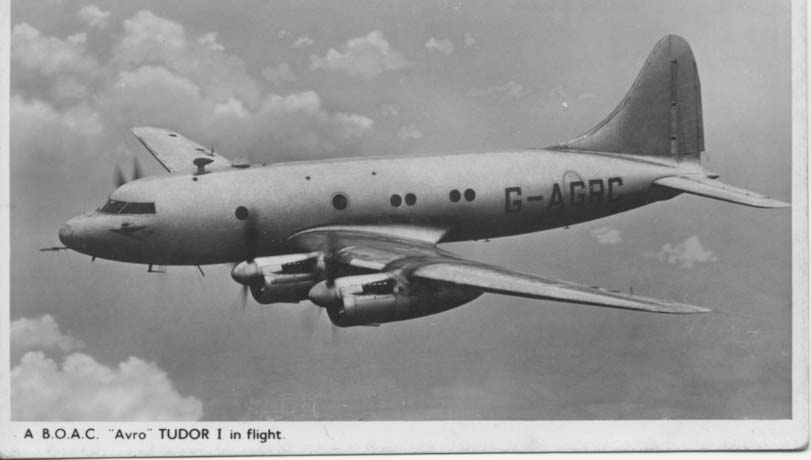 The types listed were supposed to be supplemented by a fleet of Avro Tudors but the type did not perform to specification and later , its bad safety record was a factor in the collapse of British South American Airlines. A prototype also killed its designed Roy Chadwick. Phil Munson, Surrey, UK and Club Founder has this one, apparently a BOAC issue in their colours although they never operated it, finding the Constellation far superior – Constellations however needed scarce $ and BOAC/BEA were always under pressure to use UK built types.
The types listed were supposed to be supplemented by a fleet of Avro Tudors but the type did not perform to specification and later , its bad safety record was a factor in the collapse of British South American Airlines. A prototype also killed its designed Roy Chadwick. Phil Munson, Surrey, UK and Club Founder has this one, apparently a BOAC issue in their colours although they never operated it, finding the Constellation far superior – Constellations however needed scarce $ and BOAC/BEA were always under pressure to use UK built types.
 Of these the Comet and VC-10, have a good following among collectors, reflecting their technical, if not commercial success. The Comet 4 card from BOAC is fairly common but this example, from Tony Sturgeon, Lancashire, UK is set apart by its back message, being autographed by the Captain of the first eastbound transatlantic jet service 4 October 1958.
Of these the Comet and VC-10, have a good following among collectors, reflecting their technical, if not commercial success. The Comet 4 card from BOAC is fairly common but this example, from Tony Sturgeon, Lancashire, UK is set apart by its back message, being autographed by the Captain of the first eastbound transatlantic jet service 4 October 1958.
 Geoff Dryden, Canada contributes a BOAC issue of the Super VC-10 model. Actually in the colours of the short lived BOAC-Cunard joint operation.
Geoff Dryden, Canada contributes a BOAC issue of the Super VC-10 model. Actually in the colours of the short lived BOAC-Cunard joint operation.
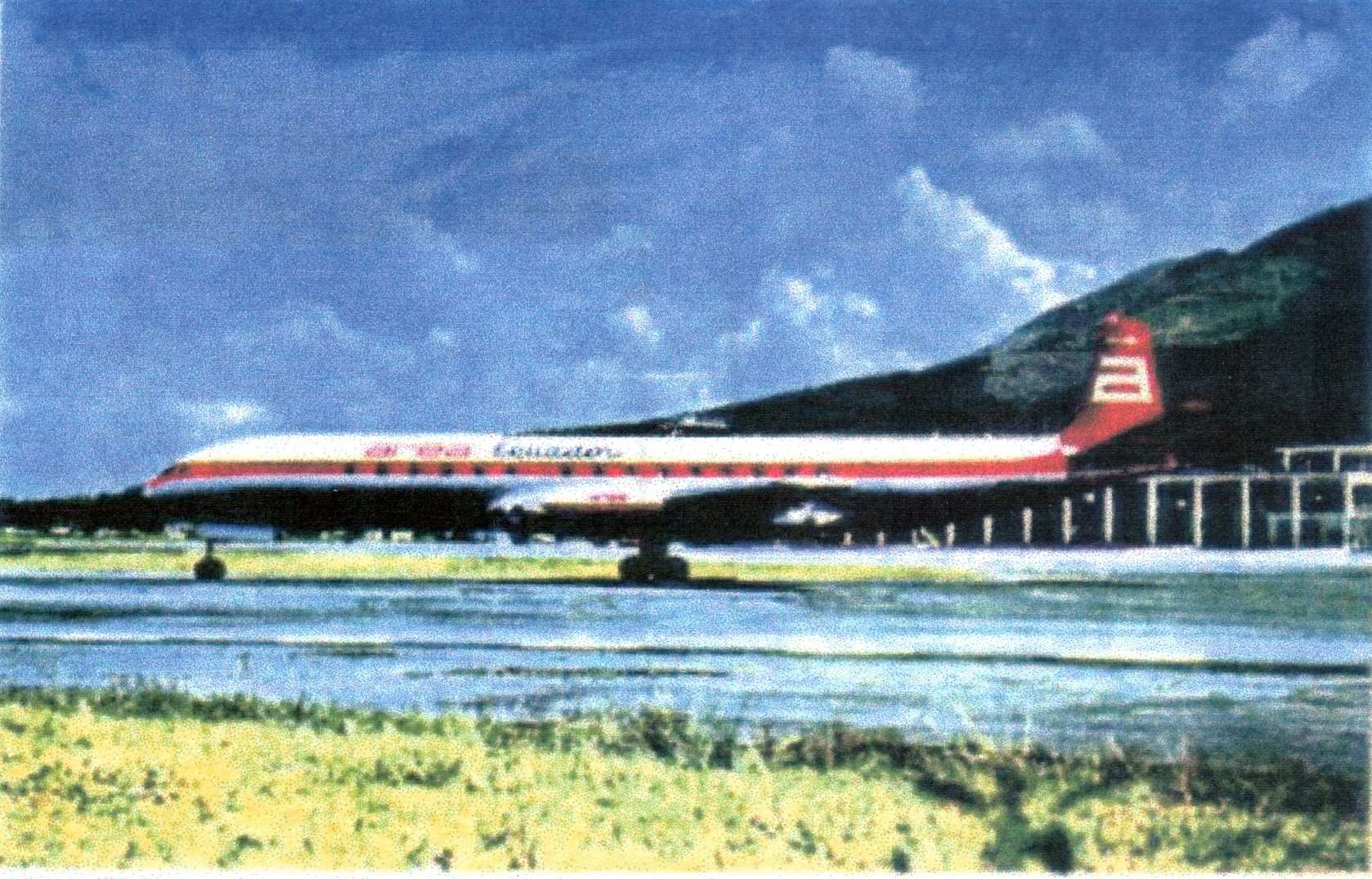 One BOAC Comet was sold to Ecuador for airline AREA who issued this card that Graham Cowell, Bingley, UK had once, sold, regrets it and has never seen it again – which is the second time we have had that story in this issue. (This is a scan of a copy so a little blurred)
One BOAC Comet was sold to Ecuador for airline AREA who issued this card that Graham Cowell, Bingley, UK had once, sold, regrets it and has never seen it again – which is the second time we have had that story in this issue. (This is a scan of a copy so a little blurred)
 Many, especially defunct, US, airlines have a following as also, increasingly, have the 1st generation jets 707 and DC-8. Both are typified by this Western Airlines Boeing 707 from Frank Lichtanski, USA who writes “I wrote to Western Air Lines in late 1962 when I was 11 years old. They sent me a timetable and two postcards--a 720B and this one. This postcard is striking for several reasons. It is the quintessential 707 portrait. Vibrant...brightly lit...slightly banked...crystal blue sky...and snow on the mountains. The aircraft is painted bright white and red in an early version of Western's "Indian Head" paint scheme. The nose treatment particularly caught my attention. The slanted angle of the black radome is highlighted with a red pin. And it matches the angle of the Indian head dress that wraps around the bottom of the fuselage. The non-fan engines and the modified "tall" vertical tail bring elegance and balance to the image. Adding to the mystique of this wonderful photo is the fact that Western's first 707s were originally destined for Cuba. Although I never got to fly on one, as a youngster I was fortunate to have had several opportunities to view Western's 707s and 720Bs at LAX.”
Many, especially defunct, US, airlines have a following as also, increasingly, have the 1st generation jets 707 and DC-8. Both are typified by this Western Airlines Boeing 707 from Frank Lichtanski, USA who writes “I wrote to Western Air Lines in late 1962 when I was 11 years old. They sent me a timetable and two postcards--a 720B and this one. This postcard is striking for several reasons. It is the quintessential 707 portrait. Vibrant...brightly lit...slightly banked...crystal blue sky...and snow on the mountains. The aircraft is painted bright white and red in an early version of Western's "Indian Head" paint scheme. The nose treatment particularly caught my attention. The slanted angle of the black radome is highlighted with a red pin. And it matches the angle of the Indian head dress that wraps around the bottom of the fuselage. The non-fan engines and the modified "tall" vertical tail bring elegance and balance to the image. Adding to the mystique of this wonderful photo is the fact that Western's first 707s were originally destined for Cuba. Although I never got to fly on one, as a youngster I was fortunate to have had several opportunities to view Western's 707s and 720Bs at LAX.”
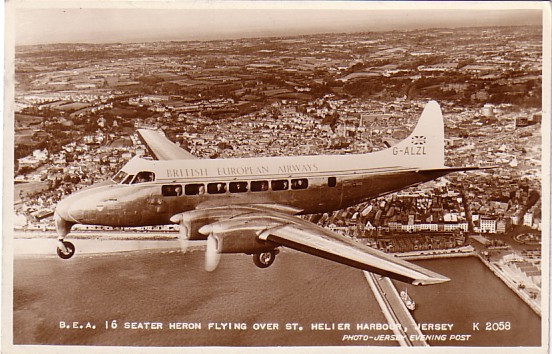 Representing BEA this card from Gordon Tutt, Sunbury, UK is also, in its way, a Channel islands card, although not an airport. The aircraft on this card from Valentine is in fact the prototype DH 114 Heron G-ALZL in BEA colours. The aircraft was later operated by Jersey Airlines named the 'Duchess of Paris'. “Not only is the quality of the photograph excellent but the printing of the card has retained the quality. It is a fine record of the Heron on a route more usually associated with BEA on routes in the Scottish Highlands and Islands. The aircraft provided not only a fast means of travel within the islands but acted a postal carrier and air ambulance for those communities. On examination of the postcard the passengers can be clearly seen looking out at the aircraft taking the photo as are also the flight crew (thankfully) The view below of St Helier is also a photographic record of the period, with some familiar features and landmarks which remain to date.”
Representing BEA this card from Gordon Tutt, Sunbury, UK is also, in its way, a Channel islands card, although not an airport. The aircraft on this card from Valentine is in fact the prototype DH 114 Heron G-ALZL in BEA colours. The aircraft was later operated by Jersey Airlines named the 'Duchess of Paris'. “Not only is the quality of the photograph excellent but the printing of the card has retained the quality. It is a fine record of the Heron on a route more usually associated with BEA on routes in the Scottish Highlands and Islands. The aircraft provided not only a fast means of travel within the islands but acted a postal carrier and air ambulance for those communities. On examination of the postcard the passengers can be clearly seen looking out at the aircraft taking the photo as are also the flight crew (thankfully) The view below of St Helier is also a photographic record of the period, with some familiar features and landmarks which remain to date.”
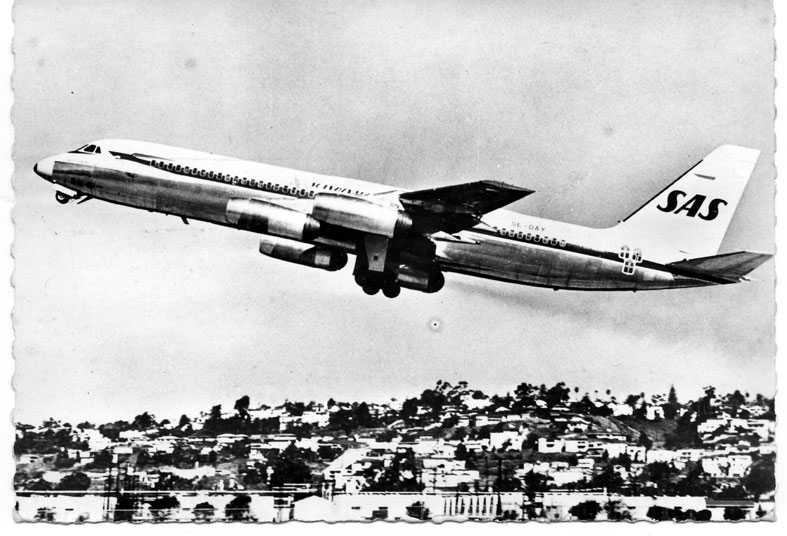 Cards aimed mainly at collectors by specialist publishers have had less of a following historically but that changes with age as many are now almost 50 years old. PI of Paris has always had a following. Frank Litaudon, France writes of them “PI started publishing airplanes and Parisian airport cards in 1953 as they obtained a monopoly for supplying Parisian airports shops with aviation related cards.This lasted over 40 years and a little less than 1000 cards where published till PI -which eventually was taken up by another editor :LECONTE- stopped publishing any aviation cards due to the end of their monopoly. Small numbers of airplane cards were not interesting any more compared to millions of Eifel tower cards that they were publishing”. This SAS Convair 990 on a B&W PI represents another early jet with a strong following in this and the earlier 880 version.
Cards aimed mainly at collectors by specialist publishers have had less of a following historically but that changes with age as many are now almost 50 years old. PI of Paris has always had a following. Frank Litaudon, France writes of them “PI started publishing airplanes and Parisian airport cards in 1953 as they obtained a monopoly for supplying Parisian airports shops with aviation related cards.This lasted over 40 years and a little less than 1000 cards where published till PI -which eventually was taken up by another editor :LECONTE- stopped publishing any aviation cards due to the end of their monopoly. Small numbers of airplane cards were not interesting any more compared to millions of Eifel tower cards that they were publishing”. This SAS Convair 990 on a B&W PI represents another early jet with a strong following in this and the earlier 880 version.
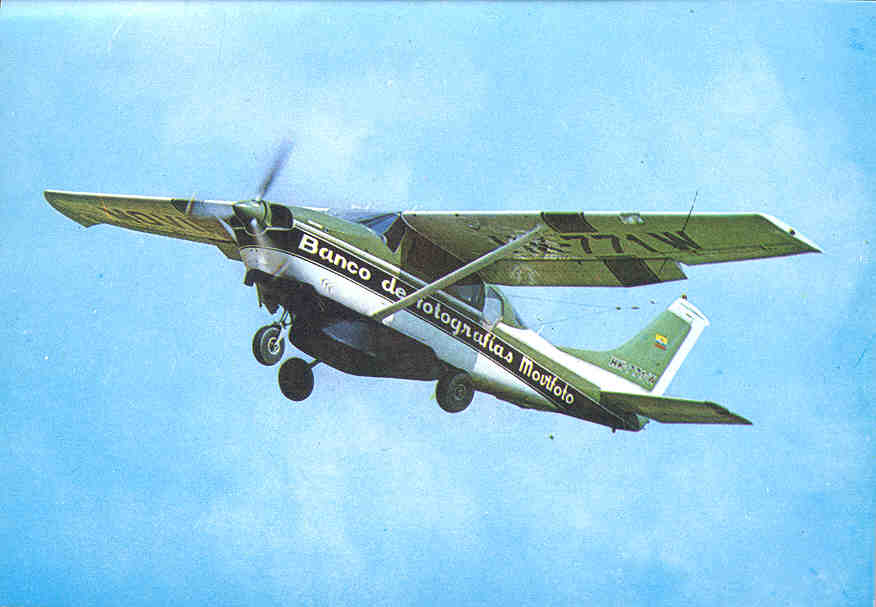 A unique publisher was Colombian company Movifoto. Their cards show mainly airliners, but also Colombian Air Force, types at, or in the sky near their home city of Medellin. They include many unusual airlines but most especially unusual angles, often showing aircraft taking off or landing viewed from above. These were made possible by the use of their own Cessna 206 lightplane and they produced this card of it, submitted by Geoff Dryden, Canada.
A unique publisher was Colombian company Movifoto. Their cards show mainly airliners, but also Colombian Air Force, types at, or in the sky near their home city of Medellin. They include many unusual airlines but most especially unusual angles, often showing aircraft taking off or landing viewed from above. These were made possible by the use of their own Cessna 206 lightplane and they produced this card of it, submitted by Geoff Dryden, Canada.
 By comparison with airliners there a fewer Military collectors. Chris Watts, France submitted this of a late WW2 RAF Hamilcar troop and equipment carrying glider – one of a large series of French cards apparently made very soon after the end of the war.
By comparison with airliners there a fewer Military collectors. Chris Watts, France submitted this of a late WW2 RAF Hamilcar troop and equipment carrying glider – one of a large series of French cards apparently made very soon after the end of the war.
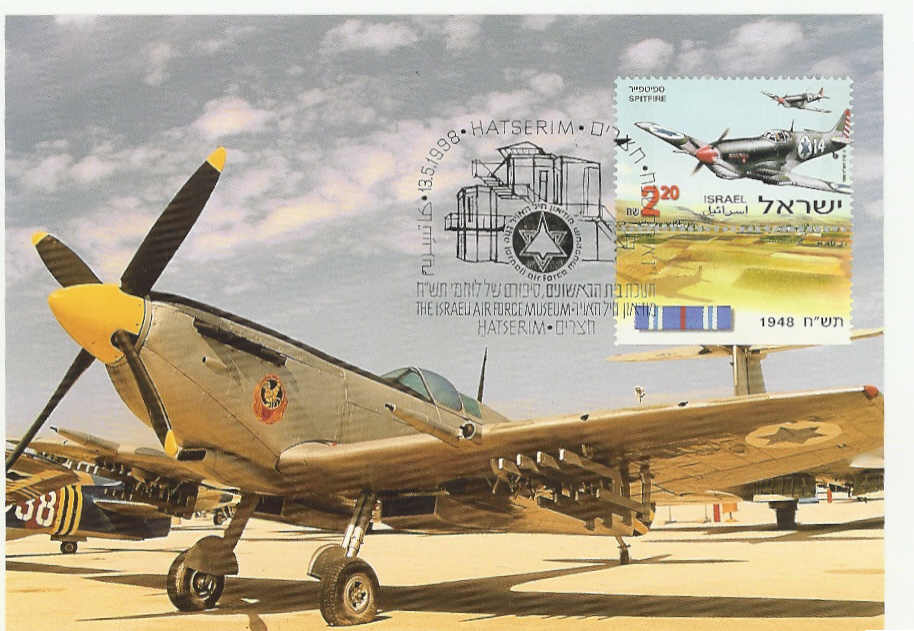 In the UK there are probably more postcards of the Spitfire issued than any other military type with cards from the 30s, WW2 and, most commonly, retrospective and preserved example cards. But the only one submitted was from Paul Lindenblatt , USA of this Israeli card commemorating its role in the 1948 war with Arab states consequent upon the founding of that state. The odd thing is that, at the beginning of that war, it was Egypt that had the Spitfires, and, to defend against them, Israel acquired Messerschmitt 109 s from Czechoslovakia.
In the UK there are probably more postcards of the Spitfire issued than any other military type with cards from the 30s, WW2 and, most commonly, retrospective and preserved example cards. But the only one submitted was from Paul Lindenblatt , USA of this Israeli card commemorating its role in the 1948 war with Arab states consequent upon the founding of that state. The odd thing is that, at the beginning of that war, it was Egypt that had the Spitfires, and, to defend against them, Israel acquired Messerschmitt 109 s from Czechoslovakia.
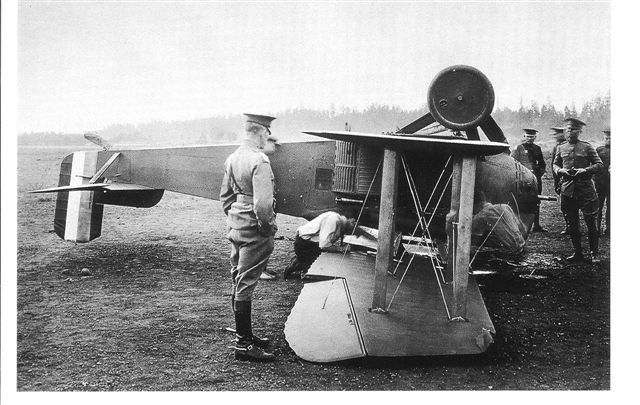 Uniting all themes are the oddball cards. Our regular features “Worth a Second Glance” and “What do you Know”, provide forums for members to respectively, highlight unusual features of a card and seek information about some odd aspect. Three cards submitted could well have appeared in these sections in a normal issue. Chris Watts, France submitted this card from a French publisher, found in France with a date of 1924 written on the back. The aircraft appeared to be French, but of an unidentified type. However the military surrounding it, cavalry by the spurs worn, are not in French uniform. Although initially appearing to be British, something in the style of uniform suggested US Army. But the type was not one known to have been operated by the AEF. It was later identified as a Boeing MB-3A of 1924 – the tail and skid are distinctive. This was far too late to have served in France, so the mystery remains of why a French publisher should feature an accident “somewhere in the USA” in 1924
Uniting all themes are the oddball cards. Our regular features “Worth a Second Glance” and “What do you Know”, provide forums for members to respectively, highlight unusual features of a card and seek information about some odd aspect. Three cards submitted could well have appeared in these sections in a normal issue. Chris Watts, France submitted this card from a French publisher, found in France with a date of 1924 written on the back. The aircraft appeared to be French, but of an unidentified type. However the military surrounding it, cavalry by the spurs worn, are not in French uniform. Although initially appearing to be British, something in the style of uniform suggested US Army. But the type was not one known to have been operated by the AEF. It was later identified as a Boeing MB-3A of 1924 – the tail and skid are distinctive. This was far too late to have served in France, so the mystery remains of why a French publisher should feature an accident “somewhere in the USA” in 1924
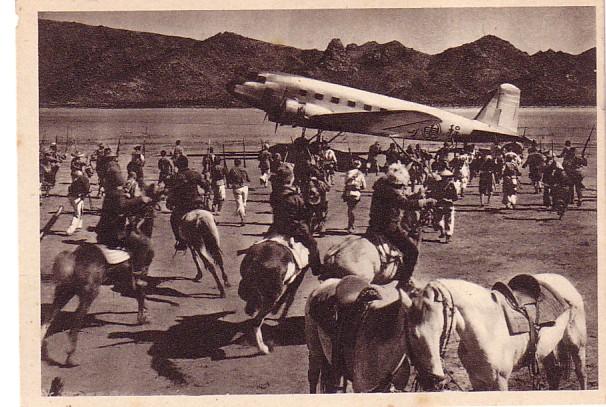 Frequent contributor Leonardo Pinzauti, Italy submitted an apparently Chinese DC-2 card. It was an Italian publicity card for the film, Lost Horizons, from 1937, starring Ronald Colman, in which a group of westerners, fleeing from a revolution in an unidentified Asian state, crash in a snowy valley in the Himalayas. They are rescued and escorted to “Shangri La” a hidden land unknown to outsiders. The card shows armed riders attempting to stop the take off. The DC-2 carries Chinese characters suggestive of the then Chinese airline CNAC. But in the 30s , whatever the supposed location, Hollywood films were shot either in the studio or on location a few miles away. Comparison of the skyline with desert airliner “boneyard” shots make it pretty clear that this is Mojave. A film history website confirms that the film was part shot at Victorville, CA , which is near to the desert airfield.
Frequent contributor Leonardo Pinzauti, Italy submitted an apparently Chinese DC-2 card. It was an Italian publicity card for the film, Lost Horizons, from 1937, starring Ronald Colman, in which a group of westerners, fleeing from a revolution in an unidentified Asian state, crash in a snowy valley in the Himalayas. They are rescued and escorted to “Shangri La” a hidden land unknown to outsiders. The card shows armed riders attempting to stop the take off. The DC-2 carries Chinese characters suggestive of the then Chinese airline CNAC. But in the 30s , whatever the supposed location, Hollywood films were shot either in the studio or on location a few miles away. Comparison of the skyline with desert airliner “boneyard” shots make it pretty clear that this is Mojave. A film history website confirms that the film was part shot at Victorville, CA , which is near to the desert airfield.
 Next, the classic, “Worth a Second Glance”, Alan Daugherty, Isle of Man submitted this card, supposedly of that island. It is a plausible picture of a late 40s Viking airliner, and, if it had been one of the BEA fleet it would have been unremarkable. But it is much rarely photographed Viking of British West Indian Airways – not pasted on to an I.o.M view, but with actually both it and the view having no connection with that island.
Next, the classic, “Worth a Second Glance”, Alan Daugherty, Isle of Man submitted this card, supposedly of that island. It is a plausible picture of a late 40s Viking airliner, and, if it had been one of the BEA fleet it would have been unremarkable. But it is much rarely photographed Viking of British West Indian Airways – not pasted on to an I.o.M view, but with actually both it and the view having no connection with that island.
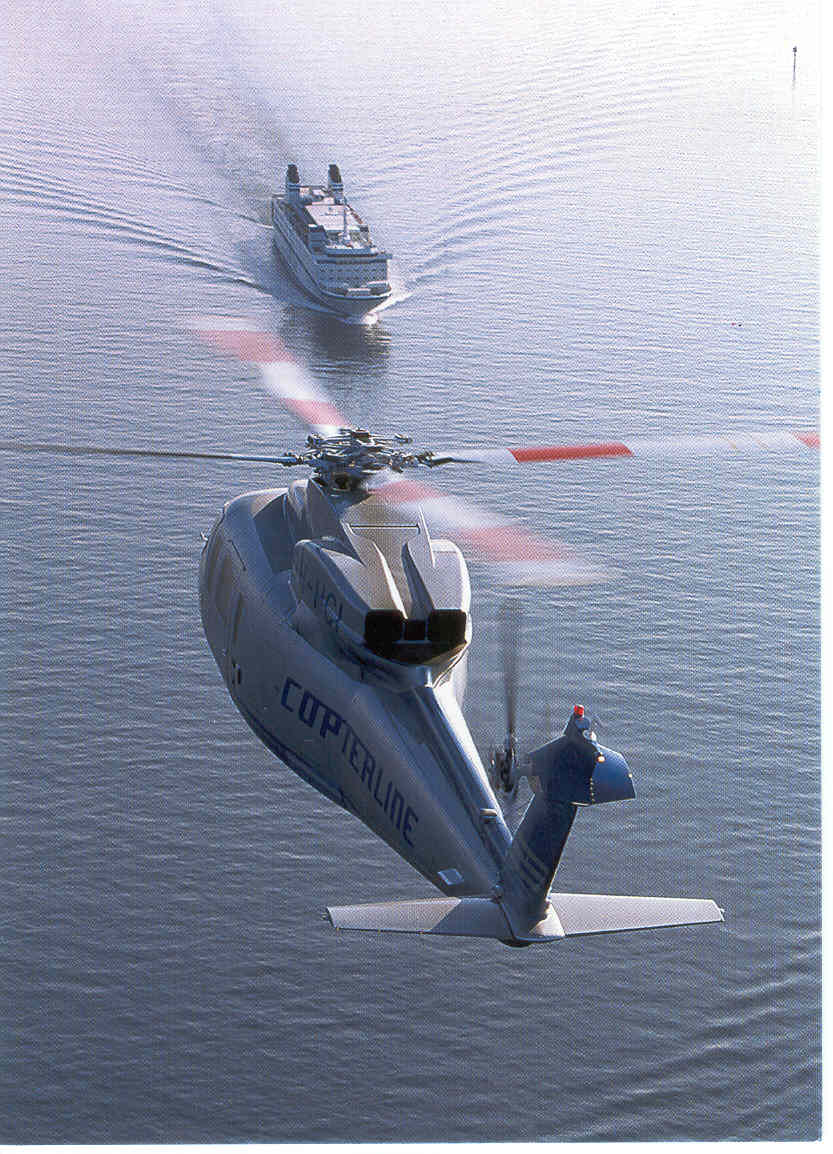 That about wraps it up. We showed 54 cards from 44 members with a good few multiple entries left over for future editions. Some subjects were not represented. Some may think others were over exposed, but that’s the way the membership responded. This last one is a good one to end on with its departing view of a Sikorsky S.76 from its Finnish operator, Copterline. Brent Wallace, Canada, describes it thus and summarises many of the reasons people collect.“. I selected this commonly available card because of its thoughtful and well illustrated qualities. It represents a successful independent helicopter airline flying on its route and it also manages to document this airline's main competition in the form of a ferry. It therefore reinforces some of the prime advantages marketed by Copterline: speed, comfort and a great view. From an enthusiast's point of view, it is always nice to see the airline's name and aircraft registration...but the prime reason for selecting this card is its beauty. The image is perfectly composed and exposed and the exotic lines of the aircraft are highlighted.”
That about wraps it up. We showed 54 cards from 44 members with a good few multiple entries left over for future editions. Some subjects were not represented. Some may think others were over exposed, but that’s the way the membership responded. This last one is a good one to end on with its departing view of a Sikorsky S.76 from its Finnish operator, Copterline. Brent Wallace, Canada, describes it thus and summarises many of the reasons people collect.“. I selected this commonly available card because of its thoughtful and well illustrated qualities. It represents a successful independent helicopter airline flying on its route and it also manages to document this airline's main competition in the form of a ferry. It therefore reinforces some of the prime advantages marketed by Copterline: speed, comfort and a great view. From an enthusiast's point of view, it is always nice to see the airline's name and aircraft registration...but the prime reason for selecting this card is its beauty. The image is perfectly composed and exposed and the exotic lines of the aircraft are highlighted.”

 Too far back to feature in “memories” the pioneer age overlaps with the “golden age” of the picture postcard. John Worsley, Sheffield UK “ As my birthplace is Shoreham I naturally chose the “flying ground” as my special interest aerodrome. It is one of oldest commercial airfields in the UK, has a fascinating history, and is still going strong. The writer, in Jan 1911, says “I think these machines are so funny, don’t you”. They are Wrights licence built by Shorts. My second card, posted Oct 1911 shows B.C Hucks Blackburn (not his usual Bleriot) at Shaftesbury Park, Newport on his West Country/Welsh tour. The card was mailed to California with the message including “ Have you any of these flying machine in California ?”
Too far back to feature in “memories” the pioneer age overlaps with the “golden age” of the picture postcard. John Worsley, Sheffield UK “ As my birthplace is Shoreham I naturally chose the “flying ground” as my special interest aerodrome. It is one of oldest commercial airfields in the UK, has a fascinating history, and is still going strong. The writer, in Jan 1911, says “I think these machines are so funny, don’t you”. They are Wrights licence built by Shorts. My second card, posted Oct 1911 shows B.C Hucks Blackburn (not his usual Bleriot) at Shaftesbury Park, Newport on his West Country/Welsh tour. The card was mailed to California with the message including “ Have you any of these flying machine in California ?”
 The USA surely did. One was aviatrix Ruth Law on this card from Charles Sterba, USA. Signed in ink, it was probably a souvenir card from the many aviation events she appeared at nationwide. Charles has another card featuring her at such an event in Iowa.
The USA surely did. One was aviatrix Ruth Law on this card from Charles Sterba, USA. Signed in ink, it was probably a souvenir card from the many aviation events she appeared at nationwide. Charles has another card featuring her at such an event in Iowa.
 Colin White, Kent UK provided an example of the real photo cards of Mays of Aldershot – a fine portrait of Texas born Samuel Franklin Cody – first to build and fly an aeroplane in the UK.
Colin White, Kent UK provided an example of the real photo cards of Mays of Aldershot – a fine portrait of Texas born Samuel Franklin Cody – first to build and fly an aeroplane in the UK.
 A link with Shoreham is that it was where O P Jones, later chief pilot of Imperial Airways and BOAC, learnt to fly. This shows him in his barnstorming days with an Avro 504 of Berkshire Aviation and is ink-autographed. This card will have to serve for the Imperial Airways interest, which, although strong, was not the subject of any submissions (card from Doug Bastin)
A link with Shoreham is that it was where O P Jones, later chief pilot of Imperial Airways and BOAC, learnt to fly. This shows him in his barnstorming days with an Avro 504 of Berkshire Aviation and is ink-autographed. This card will have to serve for the Imperial Airways interest, which, although strong, was not the subject of any submissions (card from Doug Bastin)
 ZEPPELINS feature on 2 cards. First from Bill Trower, Essex, UK shows the “Graf Zeppelin” LZ127 and is a card written and postmarked on board on 17 Sep 1930, at Friedrichshafen . Both Zeppelin cards represent the link with the postal history interest.
ZEPPELINS feature on 2 cards. First from Bill Trower, Essex, UK shows the “Graf Zeppelin” LZ127 and is a card written and postmarked on board on 17 Sep 1930, at Friedrichshafen . Both Zeppelin cards represent the link with the postal history interest.

 Brian Hyner, Birmingham, UK epitomises this. The card is actually of a warship, the German Cruiser Karlsruhe. The postal history/aviation link is on the back postmark. Background is that the Graf Zeppelin, on a scheduled service on 29 Sept 1932 was unable to land at Pernambuco Brazil due to the available ground crew being too few to cope with storm conditions. Assistance was sought from the crew of “Karlsruhe” which was anchored in the harbour. For services rendered, the crews’ mail was put aboard the Zeppelin, which reduced its transit time by approx one week. Naval mail used German stamps at inland rates and the cards carried both “Karlsruhe” ship mail and Zeppelin mail postmarks.
Brian Hyner, Birmingham, UK epitomises this. The card is actually of a warship, the German Cruiser Karlsruhe. The postal history/aviation link is on the back postmark. Background is that the Graf Zeppelin, on a scheduled service on 29 Sept 1932 was unable to land at Pernambuco Brazil due to the available ground crew being too few to cope with storm conditions. Assistance was sought from the crew of “Karlsruhe” which was anchored in the harbour. For services rendered, the crews’ mail was put aboard the Zeppelin, which reduced its transit time by approx one week. Naval mail used German stamps at inland rates and the cards carried both “Karlsruhe” ship mail and Zeppelin mail postmarks.
 COMMERCIAL AVIATION of all periods dominates the rest of the entries but within that there are many sub-themes. AIRPORTS often yield rare types and airlines and show aircraft “as is” surrounded by people, vehicles and other apron clutter which are anathema to the “perfect aircraft shot” faction. An example of a “classic” U.S prop-era real photographic airport card is this one from Jack Greenbaum, USA, of Mills Field, San Francisco, 1940s with a United DC-3 “Mainliner”
COMMERCIAL AVIATION of all periods dominates the rest of the entries but within that there are many sub-themes. AIRPORTS often yield rare types and airlines and show aircraft “as is” surrounded by people, vehicles and other apron clutter which are anathema to the “perfect aircraft shot” faction. An example of a “classic” U.S prop-era real photographic airport card is this one from Jack Greenbaum, USA, of Mills Field, San Francisco, 1940s with a United DC-3 “Mainliner”
 The once ubiquitous DC-3 is itself the object of many collections as also is the Lockheed Constellation as on this Eastern Airlines example at Detroit – Willow Run airport from Chris Slimmer, USA.
The once ubiquitous DC-3 is itself the object of many collections as also is the Lockheed Constellation as on this Eastern Airlines example at Detroit – Willow Run airport from Chris Slimmer, USA.
 You can’t get much more obscure in Airport cards than this second card from Chris Slimmer USA. DC-4 of Royal Air Lao, at Vientiane airport, Laos, and showing the airport under floodwaters. The back text in French dates the flood to 1 Sept 1966. This also appeals to the hunter/gatherer instinct by turning up for a 25 cents at a flea market.
You can’t get much more obscure in Airport cards than this second card from Chris Slimmer USA. DC-4 of Royal Air Lao, at Vientiane airport, Laos, and showing the airport under floodwaters. The back text in French dates the flood to 1 Sept 1966. This also appeals to the hunter/gatherer instinct by turning up for a 25 cents at a flea market.
 More water but this time in its right place and supporting a Short Solent of Aquila airways at Las Palmas, Canary Isles on a Dixon card. Submitted by Peter Marson, Surrey, UK but originally from Southampton, home of British flying boat operations. Flying Boats are another strong collecting theme.
More water but this time in its right place and supporting a Short Solent of Aquila airways at Las Palmas, Canary Isles on a Dixon card. Submitted by Peter Marson, Surrey, UK but originally from Southampton, home of British flying boat operations. Flying Boats are another strong collecting theme.
 More John Hinde follows (and more Nigeria), this time from Carl McQuaide Tamworth, UK combining the airport theme with other favourites VC-10 and BOAC although this one at Lagos is leased to Nigeria Airways. Like for an old Edwardian photo postcard everybody has stopped to look at the camera.
More John Hinde follows (and more Nigeria), this time from Carl McQuaide Tamworth, UK combining the airport theme with other favourites VC-10 and BOAC although this one at Lagos is leased to Nigeria Airways. Like for an old Edwardian photo postcard everybody has stopped to look at the camera.
 …and still they come from Irish publisher, John Hinde. A sub species of Airport, the heliport with BEA Helicopter at Penzance on the Scilly Isles service. Submitted by Brent Wallace, Canada who writes“. I selected this commonly available card for many reasons. It illustrates the first Sikorsky S-61 operated by BEA on its successful and long-lived scheduled service. The aircraft is in its original livery and the airline name and aircraft registration are visible. The image is colourful, documents the local countryside and shows the aircraft in service with all the usual activity (loading passengers, gate agent, flight crew, ground crew, vintage fire vehicle) rather than a sterile image of a lonely aircraft. I also like the fact that the card has been used. This adds context, tells a story and makes the card seem more historically significant in a folksy kind of way”
…and still they come from Irish publisher, John Hinde. A sub species of Airport, the heliport with BEA Helicopter at Penzance on the Scilly Isles service. Submitted by Brent Wallace, Canada who writes“. I selected this commonly available card for many reasons. It illustrates the first Sikorsky S-61 operated by BEA on its successful and long-lived scheduled service. The aircraft is in its original livery and the airline name and aircraft registration are visible. The image is colourful, documents the local countryside and shows the aircraft in service with all the usual activity (loading passengers, gate agent, flight crew, ground crew, vintage fire vehicle) rather than a sterile image of a lonely aircraft. I also like the fact that the card has been used. This adds context, tells a story and makes the card seem more historically significant in a folksy kind of way”
 AIRLINE ISSUE cards are probably the most-collected sub set of commercial aviation, probably because they relate to how the airline wished itself to be seen, are set at a point in time, and, in the past, were often available, and written on, in flight.
AIRLINE ISSUE cards are probably the most-collected sub set of commercial aviation, probably because they relate to how the airline wished itself to be seen, are set at a point in time, and, in the past, were often available, and written on, in flight.
 The types listed were supposed to be supplemented by a fleet of Avro Tudors but the type did not perform to specification and later , its bad safety record was a factor in the collapse of British South American Airlines. A prototype also killed its designed Roy Chadwick. Phil Munson, Surrey, UK and Club Founder has this one, apparently a BOAC issue in their colours although they never operated it, finding the Constellation far superior – Constellations however needed scarce $ and BOAC/BEA were always under pressure to use UK built types.
The types listed were supposed to be supplemented by a fleet of Avro Tudors but the type did not perform to specification and later , its bad safety record was a factor in the collapse of British South American Airlines. A prototype also killed its designed Roy Chadwick. Phil Munson, Surrey, UK and Club Founder has this one, apparently a BOAC issue in their colours although they never operated it, finding the Constellation far superior – Constellations however needed scarce $ and BOAC/BEA were always under pressure to use UK built types.
 Of these the Comet and VC-10, have a good following among collectors, reflecting their technical, if not commercial success. The Comet 4 card from BOAC is fairly common but this example, from Tony Sturgeon, Lancashire, UK is set apart by its back message, being autographed by the Captain of the first eastbound transatlantic jet service 4 October 1958.
Of these the Comet and VC-10, have a good following among collectors, reflecting their technical, if not commercial success. The Comet 4 card from BOAC is fairly common but this example, from Tony Sturgeon, Lancashire, UK is set apart by its back message, being autographed by the Captain of the first eastbound transatlantic jet service 4 October 1958.
 Geoff Dryden, Canada contributes a BOAC issue of the Super VC-10 model. Actually in the colours of the short lived BOAC-Cunard joint operation.
Geoff Dryden, Canada contributes a BOAC issue of the Super VC-10 model. Actually in the colours of the short lived BOAC-Cunard joint operation.
 One BOAC Comet was sold to Ecuador for airline AREA who issued this card that Graham Cowell, Bingley, UK had once, sold, regrets it and has never seen it again – which is the second time we have had that story in this issue. (This is a scan of a copy so a little blurred)
One BOAC Comet was sold to Ecuador for airline AREA who issued this card that Graham Cowell, Bingley, UK had once, sold, regrets it and has never seen it again – which is the second time we have had that story in this issue. (This is a scan of a copy so a little blurred)
 Many, especially defunct, US, airlines have a following as also, increasingly, have the 1st generation jets 707 and DC-8. Both are typified by this Western Airlines Boeing 707 from Frank Lichtanski, USA who writes “I wrote to Western Air Lines in late 1962 when I was 11 years old. They sent me a timetable and two postcards--a 720B and this one. This postcard is striking for several reasons. It is the quintessential 707 portrait. Vibrant...brightly lit...slightly banked...crystal blue sky...and snow on the mountains. The aircraft is painted bright white and red in an early version of Western's "Indian Head" paint scheme. The nose treatment particularly caught my attention. The slanted angle of the black radome is highlighted with a red pin. And it matches the angle of the Indian head dress that wraps around the bottom of the fuselage. The non-fan engines and the modified "tall" vertical tail bring elegance and balance to the image. Adding to the mystique of this wonderful photo is the fact that Western's first 707s were originally destined for Cuba. Although I never got to fly on one, as a youngster I was fortunate to have had several opportunities to view Western's 707s and 720Bs at LAX.”
Many, especially defunct, US, airlines have a following as also, increasingly, have the 1st generation jets 707 and DC-8. Both are typified by this Western Airlines Boeing 707 from Frank Lichtanski, USA who writes “I wrote to Western Air Lines in late 1962 when I was 11 years old. They sent me a timetable and two postcards--a 720B and this one. This postcard is striking for several reasons. It is the quintessential 707 portrait. Vibrant...brightly lit...slightly banked...crystal blue sky...and snow on the mountains. The aircraft is painted bright white and red in an early version of Western's "Indian Head" paint scheme. The nose treatment particularly caught my attention. The slanted angle of the black radome is highlighted with a red pin. And it matches the angle of the Indian head dress that wraps around the bottom of the fuselage. The non-fan engines and the modified "tall" vertical tail bring elegance and balance to the image. Adding to the mystique of this wonderful photo is the fact that Western's first 707s were originally destined for Cuba. Although I never got to fly on one, as a youngster I was fortunate to have had several opportunities to view Western's 707s and 720Bs at LAX.”
 Representing BEA this card from Gordon Tutt, Sunbury, UK is also, in its way, a Channel islands card, although not an airport. The aircraft on this card from Valentine is in fact the prototype DH 114 Heron G-ALZL in BEA colours. The aircraft was later operated by Jersey Airlines named the 'Duchess of Paris'. “Not only is the quality of the photograph excellent but the printing of the card has retained the quality. It is a fine record of the Heron on a route more usually associated with BEA on routes in the Scottish Highlands and Islands. The aircraft provided not only a fast means of travel within the islands but acted a postal carrier and air ambulance for those communities. On examination of the postcard the passengers can be clearly seen looking out at the aircraft taking the photo as are also the flight crew (thankfully) The view below of St Helier is also a photographic record of the period, with some familiar features and landmarks which remain to date.”
Representing BEA this card from Gordon Tutt, Sunbury, UK is also, in its way, a Channel islands card, although not an airport. The aircraft on this card from Valentine is in fact the prototype DH 114 Heron G-ALZL in BEA colours. The aircraft was later operated by Jersey Airlines named the 'Duchess of Paris'. “Not only is the quality of the photograph excellent but the printing of the card has retained the quality. It is a fine record of the Heron on a route more usually associated with BEA on routes in the Scottish Highlands and Islands. The aircraft provided not only a fast means of travel within the islands but acted a postal carrier and air ambulance for those communities. On examination of the postcard the passengers can be clearly seen looking out at the aircraft taking the photo as are also the flight crew (thankfully) The view below of St Helier is also a photographic record of the period, with some familiar features and landmarks which remain to date.”
 Cards aimed mainly at collectors by specialist publishers have had less of a following historically but that changes with age as many are now almost 50 years old. PI of Paris has always had a following. Frank Litaudon, France writes of them “PI started publishing airplanes and Parisian airport cards in 1953 as they obtained a monopoly for supplying Parisian airports shops with aviation related cards.This lasted over 40 years and a little less than 1000 cards where published till PI -which eventually was taken up by another editor :LECONTE- stopped publishing any aviation cards due to the end of their monopoly. Small numbers of airplane cards were not interesting any more compared to millions of Eifel tower cards that they were publishing”. This SAS Convair 990 on a B&W PI represents another early jet with a strong following in this and the earlier 880 version.
Cards aimed mainly at collectors by specialist publishers have had less of a following historically but that changes with age as many are now almost 50 years old. PI of Paris has always had a following. Frank Litaudon, France writes of them “PI started publishing airplanes and Parisian airport cards in 1953 as they obtained a monopoly for supplying Parisian airports shops with aviation related cards.This lasted over 40 years and a little less than 1000 cards where published till PI -which eventually was taken up by another editor :LECONTE- stopped publishing any aviation cards due to the end of their monopoly. Small numbers of airplane cards were not interesting any more compared to millions of Eifel tower cards that they were publishing”. This SAS Convair 990 on a B&W PI represents another early jet with a strong following in this and the earlier 880 version.
 A unique publisher was Colombian company Movifoto. Their cards show mainly airliners, but also Colombian Air Force, types at, or in the sky near their home city of Medellin. They include many unusual airlines but most especially unusual angles, often showing aircraft taking off or landing viewed from above. These were made possible by the use of their own Cessna 206 lightplane and they produced this card of it, submitted by Geoff Dryden, Canada.
A unique publisher was Colombian company Movifoto. Their cards show mainly airliners, but also Colombian Air Force, types at, or in the sky near their home city of Medellin. They include many unusual airlines but most especially unusual angles, often showing aircraft taking off or landing viewed from above. These were made possible by the use of their own Cessna 206 lightplane and they produced this card of it, submitted by Geoff Dryden, Canada.
 By comparison with airliners there a fewer Military collectors. Chris Watts, France submitted this of a late WW2 RAF Hamilcar troop and equipment carrying glider – one of a large series of French cards apparently made very soon after the end of the war.
By comparison with airliners there a fewer Military collectors. Chris Watts, France submitted this of a late WW2 RAF Hamilcar troop and equipment carrying glider – one of a large series of French cards apparently made very soon after the end of the war.
 In the UK there are probably more postcards of the Spitfire issued than any other military type with cards from the 30s, WW2 and, most commonly, retrospective and preserved example cards. But the only one submitted was from Paul Lindenblatt , USA of this Israeli card commemorating its role in the 1948 war with Arab states consequent upon the founding of that state. The odd thing is that, at the beginning of that war, it was Egypt that had the Spitfires, and, to defend against them, Israel acquired Messerschmitt 109 s from Czechoslovakia.
In the UK there are probably more postcards of the Spitfire issued than any other military type with cards from the 30s, WW2 and, most commonly, retrospective and preserved example cards. But the only one submitted was from Paul Lindenblatt , USA of this Israeli card commemorating its role in the 1948 war with Arab states consequent upon the founding of that state. The odd thing is that, at the beginning of that war, it was Egypt that had the Spitfires, and, to defend against them, Israel acquired Messerschmitt 109 s from Czechoslovakia.
 Uniting all themes are the oddball cards. Our regular features “Worth a Second Glance” and “What do you Know”, provide forums for members to respectively, highlight unusual features of a card and seek information about some odd aspect. Three cards submitted could well have appeared in these sections in a normal issue. Chris Watts, France submitted this card from a French publisher, found in France with a date of 1924 written on the back. The aircraft appeared to be French, but of an unidentified type. However the military surrounding it, cavalry by the spurs worn, are not in French uniform. Although initially appearing to be British, something in the style of uniform suggested US Army. But the type was not one known to have been operated by the AEF. It was later identified as a Boeing MB-3A of 1924 – the tail and skid are distinctive. This was far too late to have served in France, so the mystery remains of why a French publisher should feature an accident “somewhere in the USA” in 1924
Uniting all themes are the oddball cards. Our regular features “Worth a Second Glance” and “What do you Know”, provide forums for members to respectively, highlight unusual features of a card and seek information about some odd aspect. Three cards submitted could well have appeared in these sections in a normal issue. Chris Watts, France submitted this card from a French publisher, found in France with a date of 1924 written on the back. The aircraft appeared to be French, but of an unidentified type. However the military surrounding it, cavalry by the spurs worn, are not in French uniform. Although initially appearing to be British, something in the style of uniform suggested US Army. But the type was not one known to have been operated by the AEF. It was later identified as a Boeing MB-3A of 1924 – the tail and skid are distinctive. This was far too late to have served in France, so the mystery remains of why a French publisher should feature an accident “somewhere in the USA” in 1924
 Frequent contributor Leonardo Pinzauti, Italy submitted an apparently Chinese DC-2 card. It was an Italian publicity card for the film, Lost Horizons, from 1937, starring Ronald Colman, in which a group of westerners, fleeing from a revolution in an unidentified Asian state, crash in a snowy valley in the Himalayas. They are rescued and escorted to “Shangri La” a hidden land unknown to outsiders. The card shows armed riders attempting to stop the take off. The DC-2 carries Chinese characters suggestive of the then Chinese airline CNAC. But in the 30s , whatever the supposed location, Hollywood films were shot either in the studio or on location a few miles away. Comparison of the skyline with desert airliner “boneyard” shots make it pretty clear that this is Mojave. A film history website confirms that the film was part shot at Victorville, CA , which is near to the desert airfield.
Frequent contributor Leonardo Pinzauti, Italy submitted an apparently Chinese DC-2 card. It was an Italian publicity card for the film, Lost Horizons, from 1937, starring Ronald Colman, in which a group of westerners, fleeing from a revolution in an unidentified Asian state, crash in a snowy valley in the Himalayas. They are rescued and escorted to “Shangri La” a hidden land unknown to outsiders. The card shows armed riders attempting to stop the take off. The DC-2 carries Chinese characters suggestive of the then Chinese airline CNAC. But in the 30s , whatever the supposed location, Hollywood films were shot either in the studio or on location a few miles away. Comparison of the skyline with desert airliner “boneyard” shots make it pretty clear that this is Mojave. A film history website confirms that the film was part shot at Victorville, CA , which is near to the desert airfield.
 Next, the classic, “Worth a Second Glance”, Alan Daugherty, Isle of Man submitted this card, supposedly of that island. It is a plausible picture of a late 40s Viking airliner, and, if it had been one of the BEA fleet it would have been unremarkable. But it is much rarely photographed Viking of British West Indian Airways – not pasted on to an I.o.M view, but with actually both it and the view having no connection with that island.
Next, the classic, “Worth a Second Glance”, Alan Daugherty, Isle of Man submitted this card, supposedly of that island. It is a plausible picture of a late 40s Viking airliner, and, if it had been one of the BEA fleet it would have been unremarkable. But it is much rarely photographed Viking of British West Indian Airways – not pasted on to an I.o.M view, but with actually both it and the view having no connection with that island.
 That about wraps it up. We showed 54 cards from 44 members with a good few multiple entries left over for future editions. Some subjects were not represented. Some may think others were over exposed, but that’s the way the membership responded. This last one is a good one to end on with its departing view of a Sikorsky S.76 from its Finnish operator, Copterline. Brent Wallace, Canada, describes it thus and summarises many of the reasons people collect.“. I selected this commonly available card because of its thoughtful and well illustrated qualities. It represents a successful independent helicopter airline flying on its route and it also manages to document this airline's main competition in the form of a ferry. It therefore reinforces some of the prime advantages marketed by Copterline: speed, comfort and a great view. From an enthusiast's point of view, it is always nice to see the airline's name and aircraft registration...but the prime reason for selecting this card is its beauty. The image is perfectly composed and exposed and the exotic lines of the aircraft are highlighted.”
That about wraps it up. We showed 54 cards from 44 members with a good few multiple entries left over for future editions. Some subjects were not represented. Some may think others were over exposed, but that’s the way the membership responded. This last one is a good one to end on with its departing view of a Sikorsky S.76 from its Finnish operator, Copterline. Brent Wallace, Canada, describes it thus and summarises many of the reasons people collect.“. I selected this commonly available card because of its thoughtful and well illustrated qualities. It represents a successful independent helicopter airline flying on its route and it also manages to document this airline's main competition in the form of a ferry. It therefore reinforces some of the prime advantages marketed by Copterline: speed, comfort and a great view. From an enthusiast's point of view, it is always nice to see the airline's name and aircraft registration...but the prime reason for selecting this card is its beauty. The image is perfectly composed and exposed and the exotic lines of the aircraft are highlighted.”